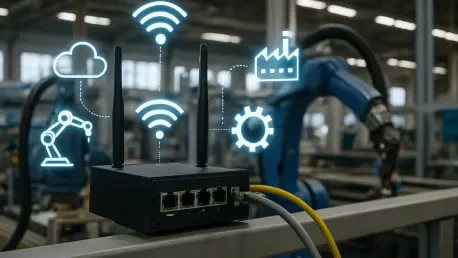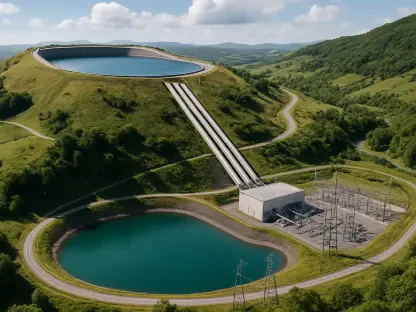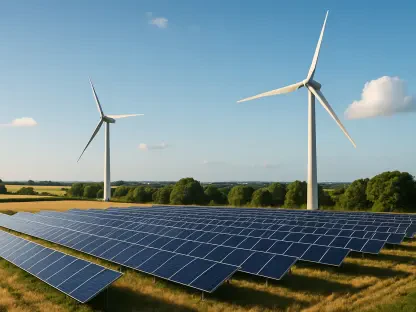The Industrial Internet of Things (IIoT) is rapidly reshaping the landscape of global industries, weaving together advanced connectivity, automation, and data analytics to drive unparalleled efficiency and innovation. As industries from manufacturing to logistics embrace this transformative technology, the potential for smarter, more responsive operations is becoming a reality. A comprehensive forecast spanning the next decade, from now until 2035, reveals that this sector is poised for a dramatic surge, positioning IIoT as a cornerstone of modern industrial evolution. This shift isn’t merely about adopting new tools; it’s about fundamentally rethinking how industrial processes operate in a data-driven world. The promise of real-time decision-making and optimized productivity is fueling enthusiasm across sectors, setting the stage for a future where smart ecosystems dominate. With such high stakes, understanding the forces behind this growth, the key players involved, and the challenges ahead becomes essential for stakeholders aiming to stay competitive in this dynamic environment.
Market Drivers and Growth Projections
Technological Advancements Fueling Expansion
The meteoric rise of IIoT is largely propelled by an urgent demand for automation and predictive maintenance, which are revolutionizing how industries manage operations. Over the next decade, until 2035, market projections indicate a substantial increase in adoption, driven by the need to minimize downtime and enhance efficiency through real-time insights. Technologies such as artificial intelligence and machine learning are playing a pivotal role, enabling systems to not only collect data but also analyze it for actionable outcomes. This integration is creating smarter industrial environments where decisions are made faster and with greater accuracy. As companies strive to remain competitive, the push for these advanced tools is intensifying, with IIoT becoming a linchpin of Industry 4.0. The financial implications are staggering, as market size estimates suggest a transformative economic impact, underscoring the technology’s critical role in future industrial strategies.
Edge computing is another catalyst accelerating IIoT’s expansion, addressing latency issues by processing data closer to its source rather than relying solely on centralized cloud systems, thus enabling faster and more efficient operations. This advancement allows for quicker responses in critical applications, such as monitoring equipment health in manufacturing plants or optimizing energy usage in utilities. By 2035, the synergy between edge computing and IIoT is expected to redefine operational capabilities, enabling industries to handle vast data volumes with minimal delay. Additionally, the growing emphasis on data-driven decision-making is pushing companies to invest heavily in infrastructure that supports these technologies. The result is a robust ecosystem where interconnected devices communicate seamlessly, driving productivity to new heights. This technological convergence is not just a trend but a fundamental shift, setting a foundation for sustained growth across diverse industrial sectors over the coming years.
Digital Transformation as a Core Driver
Digital transformation stands as a central force behind the rapid ascent of the Industrial Internet of Things (IIoT), with industries increasingly adopting connected solutions to overhaul traditional processes. This shift is about more than just technology; it represents a cultural and operational change where data becomes the lifeblood of decision-making. By leveraging IIoT, companies are transitioning from reactive to proactive strategies, using real-time analytics to anticipate issues before they arise. The forecast until 2035 highlights how this transformation will continue to gain momentum, with market expansion tied directly to the ability to integrate digital tools into everyday workflows. Such progress is particularly evident in sectors like transportation and energy, where efficiency gains translate into significant cost savings and improved service delivery, reinforcing the strategic importance of IIoT in achieving long-term business goals.
Beyond operational shifts, digital transformation through the Industrial Internet of Things (IIoT) is fostering innovation in product development and customer engagement, creating new revenue streams for forward-thinking firms. The ability to monitor and analyze performance metrics in real time allows businesses to tailor offerings to specific market needs, enhancing competitiveness. As the decade progresses toward 2035, the focus on scalability and adaptability in IIoT solutions will likely intensify, ensuring that industries of all sizes can harness these benefits. This trend is supported by growing investments in cloud computing, which provides the backbone for storing and processing the immense data generated by connected devices. The convergence of these elements is crafting a future where industrial operations are not only more efficient but also more responsive to global market dynamics, cementing IIoT’s role as a transformative force across the board.
Key Players and Competitive Dynamics
Industry Leaders Shaping the Future
At the heart of IIoT’s evolution are major corporations that are not only innovating but also setting the pace for market competition, with companies like ABB from Switzerland, Cisco Systems Inc. and Intel Corporation from the U.S., and Siemens AG from Germany leading the charge with cutting-edge solutions and strategic foresight. Their influence extends beyond product development to shaping industry standards through significant investments in research and development. These leaders are focusing on creating robust IIoT platforms that integrate seamlessly with existing systems, thereby reducing adoption barriers for other businesses. Their competitive strategies often involve leveraging partnerships to expand market reach and address complex technological challenges, ensuring they remain at the forefront of this rapidly evolving sector as it heads toward 2035.
Collaboration among these key players is proving to be a vital component in overcoming scalability issues and driving widespread IIoT adoption. By forming alliances, these companies are pooling resources to tackle intricate problems such as system integration and data security, which are critical for market growth. The competitive landscape is further defined by their ability to innovate at scale, delivering solutions that cater to diverse industrial needs while maintaining a strong focus on performance and reliability. As the market progresses toward 2035, the role of these industry giants in fostering an environment of continuous improvement cannot be overstated. Their efforts are not just shaping current trends but also laying the groundwork for future advancements, ensuring that IIoT remains a dynamic and competitive field with far-reaching implications for global industries.
Strategic Initiatives and Market Influence
The strategic initiatives undertaken by leading IIoT companies are pivotal in defining market trajectories and influencing adoption rates across sectors, as they heavily invest in technologies that enhance connectivity and data processing. Ensuring their offerings remain relevant in a fast-paced industrial landscape, these firms are also engaging in mergers and acquisitions to consolidate expertise and expand their technological portfolios. Such moves are designed to capture emerging opportunities in high-growth areas, positioning these companies to capitalize on the projected market boom by 2035. Their ability to anticipate industry needs and adapt accordingly is a testament to their market influence, driving both innovation and competition in equal measure.
Moreover, the emphasis on customer-centric solutions is reshaping how these industry leaders approach IIoT development, with a focus on delivering value through tailored applications. By engaging with end-users to understand specific operational challenges, these companies are crafting solutions that address niche requirements, from energy optimization in utilities to supply chain visibility in logistics. This targeted approach is expected to intensify as the market evolves toward 2035, with an increasing number of firms prioritizing customization to differentiate themselves in a crowded field. The ripple effect of these strategies is evident in how smaller players are compelled to innovate as well, creating a vibrant ecosystem where continuous improvement is the norm. This competitive dynamic ensures that IIoT remains a field of constant evolution and opportunity.
Regional Insights and Adoption Trends
Global Growth Patterns
The IIoT market exhibits a diverse range of growth patterns across different regions, reflecting varying levels of technological readiness and industrial focus. North America and Europe are at the forefront, benefiting from established infrastructures and early adoption of smart technologies. These regions are characterized by a strong emphasis on innovation, with significant investments in research and development driving IIoT integration in sectors like manufacturing and healthcare. Meanwhile, the Asia-Pacific region is emerging as a high-growth hub, fueled by rapid industrialization and substantial government backing for smart manufacturing initiatives. This disparity in adoption rates highlights the unique economic and policy factors at play, shaping how IIoT unfolds globally as the timeline progresses toward 2035.
Beyond these leading areas, regions such as Latin America, the Middle East, and Africa are carving out their own paths in IIoT adoption, albeit at a slower pace due to infrastructure constraints and varying levels of industrial maturity. However, growing investments in digital transformation are beginning to bridge these gaps, with local governments and businesses recognizing the long-term benefits of connected technologies. The forecast until 2035 suggests that these regions will see accelerated growth as connectivity improves and implementation costs decrease. This global mosaic of adoption trends underscores the importance of tailored strategies that account for regional nuances, ensuring that IIoT solutions are both accessible and relevant to diverse industrial landscapes. The interplay of these dynamics is creating a complex but promising picture of global market expansion.
Infrastructure and Policy Impacts
Infrastructure readiness plays a critical role in determining the pace of IIoT adoption across different geographies, with well-developed regions reaping immediate benefits from their advanced technological foundations. In North America and Europe, robust communication networks and widespread access to high-speed internet facilitate seamless integration of IIoT systems, enabling industries to capitalize on real-time data and automation. Conversely, regions with less developed infrastructure face hurdles in deploying these technologies at scale, often requiring significant upfront investments to modernize systems. As the market moves toward 2035, bridging this digital divide will be essential to ensure equitable growth, with international collaboration and funding likely to play a key role in supporting emerging economies.
Government policies are equally influential in shaping regional IIoT landscapes, with supportive regulations accelerating adoption in many areas. Incentives such as tax breaks for smart technology investments and grants for research initiatives are proving effective in regions like Asia-Pacific, where policymakers are prioritizing industrial modernization. These measures are fostering environments conducive to innovation, encouraging both local and foreign companies to invest in IIoT solutions. By 2035, the impact of such policies is expected to become even more pronounced, with harmonized standards and cross-border cooperation potentially streamlining global implementation. This interplay between infrastructure and policy underscores the multifaceted nature of IIoT growth, highlighting the need for coordinated efforts to maximize its transformative potential worldwide.
Challenges and Barriers to Growth
Overcoming Obstacles
Despite the promising outlook for IIoT, significant challenges loom large, threatening to impede its widespread adoption if not addressed effectively. Cybersecurity risks stand out as a primary concern, with interconnected systems becoming prime targets for data breaches and malicious attacks. The complexity of securing vast networks of devices requires robust measures, including advanced encryption and continuous monitoring, to safeguard sensitive industrial data. Additionally, interoperability issues arise from the lack of standardized protocols, often leading to integration difficulties across diverse systems. As the market advances toward 2035, tackling these obstacles through collaborative industry efforts and technological innovation will be crucial to maintaining growth momentum and ensuring trust in IIoT ecosystems.
High initial investment costs further complicate the adoption landscape, particularly for small and medium-sized enterprises that may lack the capital to implement comprehensive IIoT solutions. These financial barriers can delay the realization of efficiency gains, creating disparities in market participation. However, strategies such as phased implementations and subscription-based models are emerging as viable solutions to lower entry costs, making IIoT more accessible. By 2035, the expectation is that cost-effective innovations and financing options will help democratize access, allowing a broader range of industries to benefit from connected technologies. Addressing these financial and technical hurdles through targeted policies and industry partnerships will be essential to unlocking the full potential of IIoT across varied operational contexts.
Mitigating Risks for Sustainable Progress
The path to sustainable IIoT growth hinges on proactive risk mitigation strategies that address both current and emerging threats, ensuring a secure foundation for future advancements. Beyond cybersecurity, data privacy concerns are gaining prominence as industries grapple with regulatory requirements and consumer expectations around information protection. Developing frameworks that prioritize transparency and compliance is becoming a necessity to build confidence among stakeholders. As the timeline extends to 2035, the adoption of global standards for data handling and security will likely play a pivotal role in harmonizing practices across borders, reducing vulnerabilities in interconnected systems. This focus on risk management is not just about prevention but also about fostering an environment where innovation can thrive without compromising safety.
Moreover, the challenge of workforce readiness cannot be overlooked, as the shift to Industrial Internet of Things (IIoT) demands new skills and expertise that many industries currently lack. Training programs and educational initiatives are vital to equip employees with the knowledge needed to operate and maintain advanced systems effectively. By 2035, partnerships between educational institutions and industry leaders are expected to bridge this skills gap, ensuring a steady supply of qualified professionals to support IIoT deployment. This multifaceted approach to mitigating risks—encompassing technology, regulation, and human capital—will be instrumental in sustaining market growth. The emphasis on preparedness and adaptability reflects a broader commitment to balancing innovation with stability in the evolving industrial landscape.
Emerging Trends and Strategic Focus
Digital Transformation and Sustainability
A defining trend in the IIoT market is its role as a catalyst for digital transformation, fundamentally altering how industries approach operational efficiency and strategic planning. The integration of connected devices enables a shift from manual, siloed processes to automated, interconnected systems that provide real-time visibility and control. This transformation is particularly impactful in sectors like manufacturing, where IIoT facilitates just-in-time production and reduces waste through precise monitoring. Looking ahead to 2035, the deepening of digital integration is expected to create more agile and responsive industrial frameworks, capable of adapting to market shifts with unprecedented speed. The focus on leveraging data for strategic advantage is reshaping competitive priorities, pushing companies to rethink their operational models in profound ways.
Sustainability is another critical dimension of IIoT’s influence, with industries increasingly using connected technologies to optimize energy consumption and minimize environmental impact. Smart sensors and analytics allow for precise tracking of resource usage, enabling firms to implement greener practices without sacrificing productivity. This alignment with global environmental goals is becoming a key differentiator, as stakeholders prioritize solutions that balance profitability with responsibility. By 2035, the expectation is that IIoT will play an even larger role in supporting sustainability initiatives, driven by regulatory pressures and societal demand for eco-friendly practices. This trend highlights the broader potential of IIoT to address not only operational challenges but also pressing global issues, reinforcing its strategic importance in the industrial sphere.
Customization and Scalability in Solutions
The growing demand for customized IIoT solutions reflects the diverse needs of industries, each requiring tailored approaches to address specific operational challenges. Unlike one-size-fits-all technologies, these bespoke systems are designed to integrate seamlessly with existing infrastructures, whether in logistics for enhanced tracking or in energy for optimized grid management. This trend toward personalization is gaining traction as companies recognize the value of solutions that align closely with their unique workflows. As the market progresses toward 2035, the availability of flexible, modular IIoT platforms is expected to increase, allowing businesses to adopt technologies incrementally while maximizing return on investment. This focus on customization is reshaping vendor strategies, emphasizing client collaboration to deliver impactful results.
Scalability remains a complementary priority, ensuring that IIoT solutions can grow alongside expanding industrial needs without requiring complete overhauls. The ability to scale systems efficiently is particularly crucial for industries experiencing rapid growth or seasonal fluctuations, where adaptability can mean the difference between success and stagnation. By 2035, advancements in cloud-based architectures and edge processing are anticipated to enhance scalability, enabling seamless expansion of connected networks. This dual emphasis on customization and scalability underscores a strategic shift in the IIoT market, where flexibility and foresight are paramount. The commitment to meeting diverse, evolving demands positions IIoT as a versatile tool for future-proofing industrial operations across a wide array of applications.









